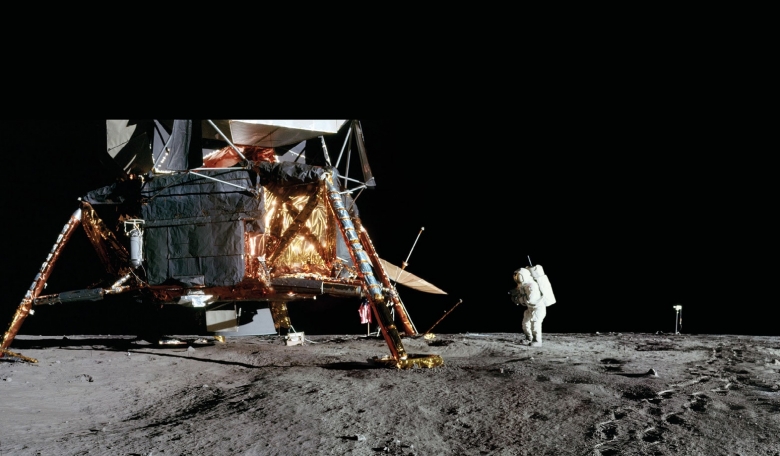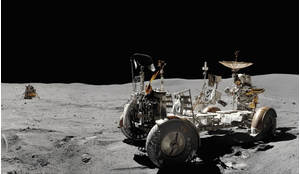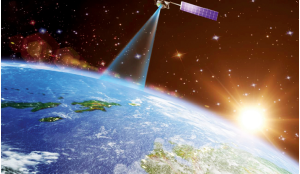The first Apollo moonwalk in July 1969 was watched by millions of people all over the world and became a great moment in humankind’s history. Five more successful landing missions followed Apollo 11 and each successive soacecraft touched down amongst more challenging terrain and for a longer duration. Thousands of high quality photographs were returned showing stunning scenery from huge craters, valleys and rilles to vast mountain ranges. Many of the photographs taken were part of panoramic sequences where the astronaut turned on the spot in a 360 degree circle whilst capturing frames. These images would later be printed out and assembled to form complete panoramic mosaics. Designer Mike Constantine has used digital technology to seamlessly blend between 15 and 25 separate frames to produce a collection of high resolution panoramas. The resulting images - just released in a new large format book and some of which are reproduced here - are beautiful, high-quality vistas that offer the viewer an astronaut’s eye-view of the lunar surface.
 Jim Irwin, Apollo 15 lunar module pilot, captured this all encompassing panorama at the end of EVA-2. On the far left the upside-down tripod object is the Lunar Surface Magnetometer, and then Dave Scott can be seen picking up the Lunar Surface Drill. The white box-type object at the bottom of the shot is the Solar Wind Spectrometer and to the right of that is the Heat Flow Electronics box. Mount Hadley and the Swann range are in the background and, on the far right, is the lunar rover and the more distant lunar module.
Jim Irwin, Apollo 15 lunar module pilot, captured this all encompassing panorama at the end of EVA-2. On the far left the upside-down tripod object is the Lunar Surface Magnetometer, and then Dave Scott can be seen picking up the Lunar Surface Drill. The white box-type object at the bottom of the shot is the Solar Wind Spectrometer and to the right of that is the Heat Flow Electronics box. Mount Hadley and the Swann range are in the background and, on the far right, is the lunar rover and the more distant lunar module.
 This Apollo 15 EVA-2 panorama gives a great view of the immediate landing site, with the Minus Z strut of the lunar module inside a small crater, giving a pronounced tilt and almost causing the engine bell to touch the lunar surface. Barely visible in the far distance on the right, Dave Scott is standing in front of the lunar rover adjusting the high-gain antenna to point directly at Earth.
This Apollo 15 EVA-2 panorama gives a great view of the immediate landing site, with the Minus Z strut of the lunar module inside a small crater, giving a pronounced tilt and almost causing the engine bell to touch the lunar surface. Barely visible in the far distance on the right, Dave Scott is standing in front of the lunar rover adjusting the high-gain antenna to point directly at Earth.
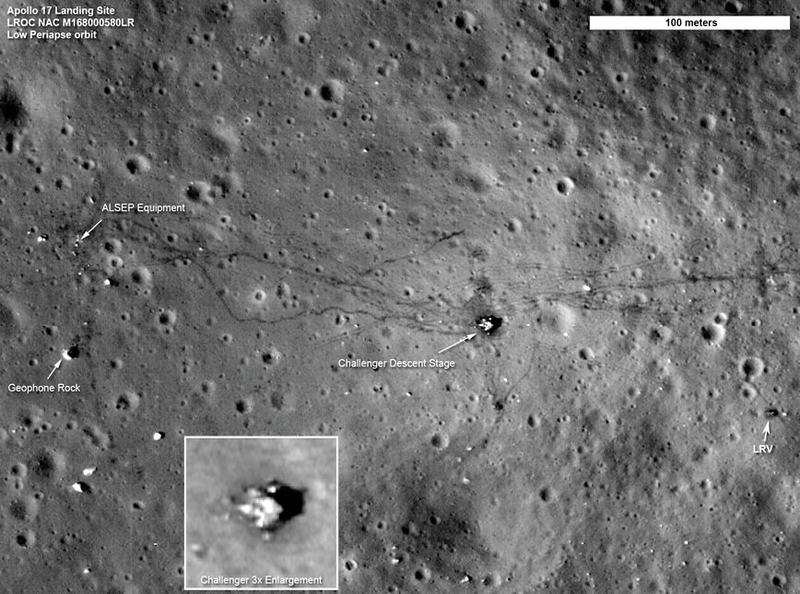 Some 37 years after Apollo 17, NASA’s Lunar Reconnaissance Orbiter overflew the landing site at an altitude of 50 km and captured photographs at a resolution of 50 cm per pixel. The resulting image clearly shows the LM, the rover and its tracks.
Some 37 years after Apollo 17, NASA’s Lunar Reconnaissance Orbiter overflew the landing site at an altitude of 50 km and captured photographs at a resolution of 50 cm per pixel. The resulting image clearly shows the LM, the rover and its tracks.
 An evocative black & white panorama showing what a diverse and geologically interesting location was chosen for Apollo 15. Dave Scott can be seen on the slope of Mount Hadley measuring the size of rocks whilst the lunar rover, sitting at the bottom of the slope, has its high gain antenna pointing directly at Earth. The right side of this panorama is dominated by the breathtaking Hadley Rille, as it meanders across the Hadley Plain.
An evocative black & white panorama showing what a diverse and geologically interesting location was chosen for Apollo 15. Dave Scott can be seen on the slope of Mount Hadley measuring the size of rocks whilst the lunar rover, sitting at the bottom of the slope, has its high gain antenna pointing directly at Earth. The right side of this panorama is dominated by the breathtaking Hadley Rille, as it meanders across the Hadley Plain.
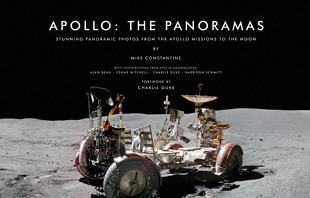 The book cover of ‘Apollo: The Panoramas’ - www.moonpans.com
The book cover of ‘Apollo: The Panoramas’ - www.moonpans.com





